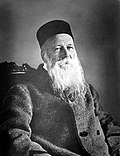International Red Cross and Red Crescent Movement
The International Red Cross and Red Crescent Movement is a movement to save human life and health. Its headquarters are in Geneva, Switzerland.
Although it is a big international organisation, it is privately run. No government controls the Red Cross.
The Red Cross has a special job, given by international law. It is the only private group to have its jobs set out by international law.
Three things make up the movement:

- The International Committee of the Red Cross (ICRC) was created in 1863 in Geneva. Its job, under international law, is to protect the life and dignity of the victims of war.
- The International Federation of Red Cross and Red Crescent Societies (IFRC) was founded in 1919. It tries to make sure the national Red Cross and Red Crescent Societies can work together and organise relief assistance missions in case of large-scale emergencies. The International Federation Secretariat is also based in Geneva, Switzerland.
- There is a Red Cross and Red Crescent society in nearly every country in the world. 186 National Red Cross and Red Crescent Societies are recognized by the ICRC and admitted as full members of the Federation. Each one works in its home country, following the ideas of international humanitarian law and the statutes of the international Movement. If possible National Societies can take on additional humanitarian tasks that are not directly defined by international humanitarian law or the mandates of the international Movement. The British Red Cross Society, for example, organises volunteer ambulances at public events. The German Red Cross operates a blood bank and a professional full-time ambulance service for hospitals.


 The Red Cross, the Red Crescent and the Red Crystal,
The Red Cross, the Red Crescent and the Red Crystal,
the three international symbols of the Red Cross
Goals
According to the Geneva conventions, there are five goals for International red cross and red crescent movements;
- To monitor compliance of warring parties with the Geneva Conventions
- To organize nursing and care for those who are wounded on the battlefield
- To supervise the treatment of prisoners of war and treat them
- To help with the search for missing persons in a war (tracing service)
- To organize protection and care for normal people
- To make peace between groups in war
International Red Cross And Red Crescent Movement Media
The Red Cross, after the Battle of Gravelotte in 1870
Henry Dunant, author of A Memory of Solferino
Original document of the First Geneva Convention, 1864
Memorial commemorating the first use of the Red Cross symbol in an armed conflict during the Battle of Dybbøl (Denmark) in 1864; jointly erected in 1989 by the national Red Cross societies of Denmark and Germany
Gōtarō Mikami's Red Cross flag with which in 1905 he prevented an attack by the Russian army
War 1914–1918. Geneva, Rath Museum. International Prisoners-of-War Agency. Researches department. German section. Express messages and communications to families.
Other websites
| Wikimedia Commons has media related to Lua error in Module:Commons_link at line 62: attempt to index field 'wikibase' (a nil value).. |
- International Red Cross and Red Crescent Movement Official Website Archived 2007-08-12 at the Wayback Machine (in English, French, Spanish, and Arabic)









